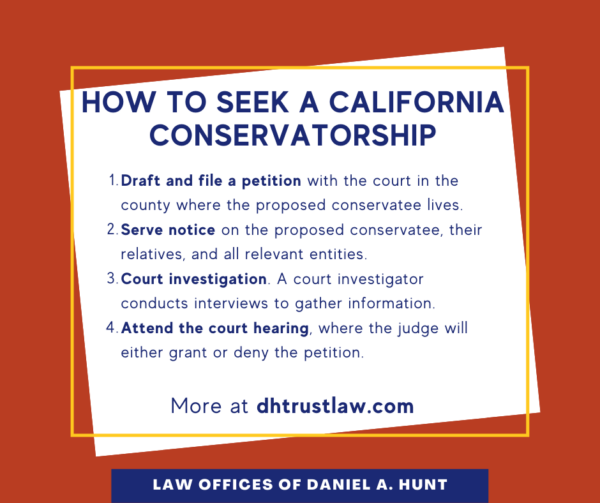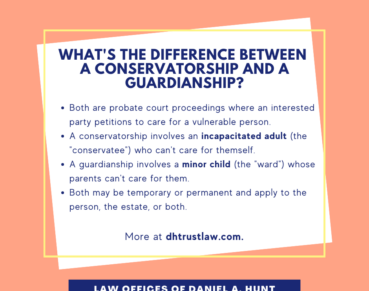How to Get a California Conservatorship

If you know and want to help an adult with limited or no capacity, you need to understand how to get a California conservatorship. Before seeking court approval to meet that person’s needs, it will be helpful to understand each step of this process. Here’s a step-by-step overview of how to get a California conservatorship.
1. Draft a petition.
To begin the process of seeking a conservatorship, a petition must be drafted. The petition is usually prepared by the proposed conservator, but also may be prepared by:
- The proposed conservatee (if they have the requisite capacity)
- A spouse, domestic partner, relative, or friend of the proposed conservatee
- Another interested person
- An interested state or local agency, employee of the agency, or public officer
The petition should clearly demonstrate to the court why a conservatorship is needed and include the following:
- Relevant information about the proposed conservator and conservatee, relatives, and the petitioner (person filing the case in court).
- Reasons a conservatorship is necessary.
- Reasons that potential alternatives to a conservatorship won’t be feasible in this case.
An experienced conservatorship attorney can ensure that the petition includes all of the necessary information.
2. File the petition with the court.
Once the petition is complete, the petitioner (or their attorney) must file the petition with the court clerk in the county where the proposed conservatee lives. They must pay a filing fee (currently $435). They must also pay a court investigator fee. This fee is set by the court but may be waived based on the size of the proposed conservatee’s estate. Then the clerk will schedule a court date for a hearing. If the proposed conservatee lacks capacity, the petitioner should also seek ahead of the hearing for the court to appoint counsel for the proposed conservatee.
3. Serve notice on the proposed conservatee.
The petitioner must have a disinterested party personally deliver a citation and a copy of the petition to the proposed conservatee.
4. Serve notice on the proposed conservatee’s relatives and relevant entities.
The petitioner must have disinterested party mail a written notice about the conservatorship court hearing AND a copy of the petition to the conservatee’s spouse/domestic partner (if any) and to all relatives that are within the second degree. This helpful table can help you determine who is within the second degree.
If the proposed conservatee is receiving Veteran Benefits or certain social service benefits like regional care center services, then you must notice these entities by mail of the petition and hearing.
5. Court investigation.
A court investigator will talk to the proposed conservatee and others who may be familiar with the conservatee’s condition. The court will charge the conservatee’s estate for the cost of this investigation, unless the court decides that the assessment would be a hardship for the conservatee.
Likewise, if the court appoints independent counsel for the proposed conservatee, that attorney will need to interview their client (the proposed conservatee), and submit a report to the court regarding the conservatee’s interests in being conserved.
In addition, if the proposed conservatee is receiving services from regional care centers (like Alta California Regional Center), then the agency will also submit a report regarding their opinion on the levels of restrictions that should be applied to the proposed conservatee’s rights.
6. Attend the court hearing.
The proposed conservator and conservatee must attend the court hearing (unless the conservatee is excused due to poor health). At the hearing, a judge will determine if everyone has been properly notified and if a lawyer needs to be appointed to represent the proposed conservatee, if one was not already appointed.
Once the judge is ready to make a decision, they may grant or deny the conservatorship. If the judge grants the petition, the following steps will be taken:
- An order appointing the conservator will be filed with the court.
- The court will issue Letters of Conservatorship to the conservator.
- If the conservatee has an estate, the judge will require the conservator to file a surety bond (unless the court orders the conservatee’s bank accounts to be frozen). The judge will set the amount of the bond based on the estate size. The proposed conservator will pay an annual premium for the bond, which serves to protect the estate against potential misconduct by the conservator.
- The conservator must purchase or download a copy of the Handbook for Conservators.
- The conservator must attend the conservator training offered by the court.
At this point, the conservator can assume the powers authorized under the law. The conservator will have an ongoing duty to report to the court and to meet with the court investigator regularly for reviews.
Law Offices of Daniel A. Hunt
The Law Offices of Daniel A. Hunt is a California law firm specializing in Estate Planning; Trust Administration & Litigation; Probate; and Conservatorships. We've helped over 10,000 clients find peace of mind. We serve clients throughout the greater Sacramento region and the state of California.




